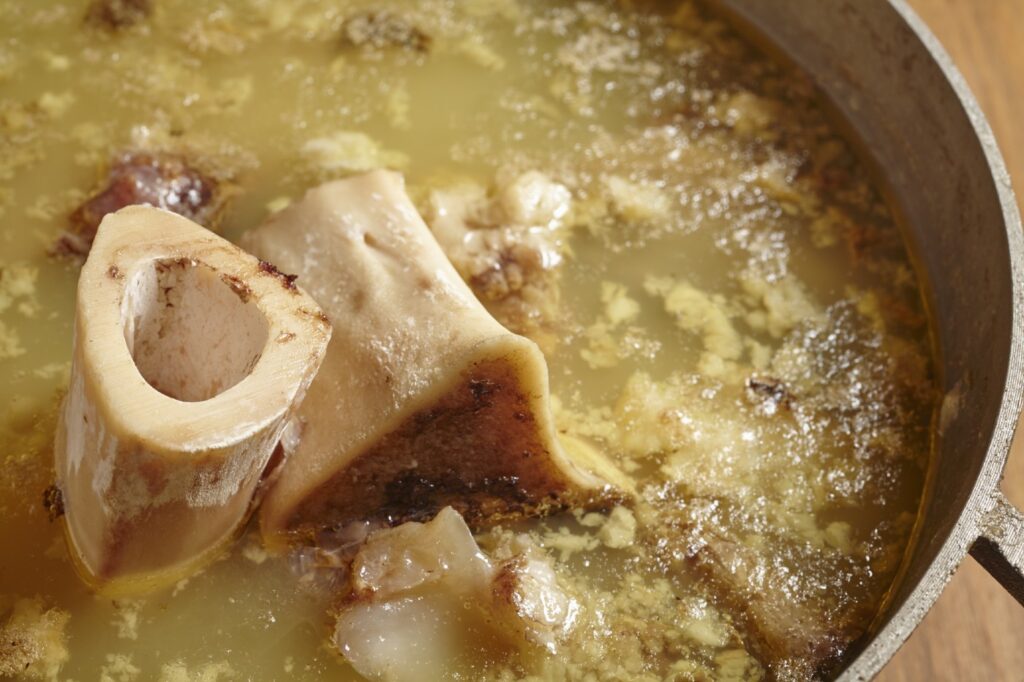For several years now, collagen-rich bone broth—created by boiling bones to extract the gelatin and marrow within—has become popular on the health and wellness magazine circuit. And for good reason.

The simple dish confers a set of valuable nutrients, like glutamine and collagen, that are uncommon in other foods.
According to Healthline, animal bones are also rich in calcium, magnesium, potassium, phosphorus, and other trace minerals that help build and strengthen our own human bones.
Bone broth also promotes gut and digestive health, supports joint mobility, skin, hair, teeth, and nails, and even better sleep. Other health benefits include an improved immune system and faster muscle recovery.
But while the soup, made simply by boiling the bones of animals, is always referred to as “bone broth,” is there any meaningful difference between it and the cooking stock our mothers used as the base for chicken noodle soup when we were sick?
The answer is very important, because there are likely many people who could benefit tremendously from bone broth’s health benefits, but can’t afford to buy health food store prices.
Stock vs bone broth
On a surface level, the answer is no, but it depends on the ingredients list, as a product can call itself anything—bone broth, cooking stock, chicken stock, or just “broth,” but unless it has the ingredients of something like Kettle & Fire or another commercial kind of bone broth, it’s just flavored water.
Many broth recipes lean heavily on things like bayleaf, onion, carrot, celery, sage, or other vegetables and aromatics to add flavor to soup, and should not be considered a dietary supplement in the way commercial bone broth is.
On the other hand, while some high-profile bone broth companies like the aforementioned Kettle & Fire charge $8-10 a quart, there may be common beef or chicken stock at your average supermarket (Trader Joe’s comes to mind) with very similar levels of bones and nutrients to something you’d see in a health food store that costs 4x as much.
All you have to do is look at the nutrition facts. What are the first and second ingredients? Somewhere right at the top should be something like beef knuckles or chicken carcass. You don’t want to see things like vegetable oils, or aromatics of: onion, carrot, peas, and so on, as this doesn’t actually indicate the presence of vegetables.
MORE: ‘Coronavirus Cooking Survey’ Finds That People Are Eating Healthier and Wasting Less Food
Next look at the nutrient values. Good bone broth should have higher amounts of protein and sodium, and small amounts of calcium and potassium. This likely indicates the presence of collagen, glutamine—which is where the health benefits are.
Tips to making your own
Bone broth is easy to make, and requires only a bit of intuition and common sense.
- Ask your local butcher if he has bones to get rid of or that he would consider selling at a low price. Bones on the legs, feet, and spine of a cow or chicken will have greater densities of marrow and gelatin and should be preferred to other kinds.
- Use any leftovers you have from any animal. If you’re buying bone-in meats, see about getting those with larger bones.
- Use vegetables and especially herbs to give it a bit of flavor and stop your broth from tasting like gristle.
- Use a pan with a lid! You likely don’t want your house to smell like bone broth.
SHARE The Bone Broth Benefits With Your Friends On Social Media…





















Check the frozen foods section of your supermarket. Many of them carry frozen beef bones. I just got some last week. The soup’s on the stove now.
Yum!
I get the Beef bones from a local Farmers Market and make vegetable tomato soup…delish and you start to feel better instantly